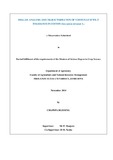Please use this identifier to cite or link to this item:
https://cris.library.msu.ac.zw//handle/11408/2531| Title: | Diallel analysis and characterisation of verticillium wilt tolerance in cotton (gossypium hirsutum l.) | Authors: | Chapera, Blessing | Keywords: | Cotton production Climate variations |
Issue Date: | Nov-2014 | Publisher: | Midlands State University | Abstract: | Cotton production is generally declining due to several limitations which include climate variations, poor crop management and biotic stress factors. Of the biotic stress, diseases are a major limiting factor of cotton production. Verticillium wilt is one of the most important disease and is an economically important fungal disease causing significant losses to seed cotton yield in Zimbabwe. Varietal development for resistance in cotton requires the understanding of the underlying genetic control of Verticillium wilt tolerance. Resistant breeding material against the disease is available but further improvement has to be done on other traits of economic importance. Thus, five local varieties with varying tolerance to the disease and different yield potentials were crossed in a half diallel mating design in 2013. This was done in order to elucidate the inheritance pattern and gene action of the resistance traits of the cotton lines. The ten crosses and five parents that were produced by the mating system were screened against Verticillium wilt by artificial inoculation at Cotton Research Institute, Kadoma in a glasshouse in 2014. These cotton lines were characterised using agronomic and morphological markers to identify Verticillium wilt resistance gene movements from parent lines to offspring. The trial was laid out in a completely randomised design with three replications due to the homogeneity conditions that prevailed in the glasshouse. Screening for Verticillium wilt resistance was done using a disease severity scoring on a scale of 1-6 and vascular brown index (VBI) scoring on a scale of 1-4. Morphological and agronomical markers were evaluated and used to group similar lines through cluster analysis. There were significant variations on most of the morphological and agronomical traits. Significant variations in disease severity and the vascular brown index were observed for the cotton lines produced in the half diallel mating system. The general combining ability (GCA) for the parents and specific combining ability (SCA) for the crosses were also significant. The Verticillium wilt severity scores ranged from 1.22 to 3.07 and VBI scores ranged from 0.78 to 2.77. The contribution of GCA to the total sum of squares of crosses for disease scores ranged from 86.9 to 95.2 % compared to SCA that ranged from 4.8 to 14.2 %. Additive gene effects were more important than non-additive effects indicating that Verticillium wilt resistance is genetically determined and that selection should be successful to improve resistance. Selection of parents with good GCA effects will be important for success in Verticillium wilt resistance breeding in cotton. | URI: | http://hdl.handle.net/11408/2531 |
| Appears in Collections: | Master of Science in Crop Science |
Files in This Item:
| File | Description | Size | Format | |
|---|---|---|---|---|
| DIALLEL ANALYSIS FINAL DISSERTATION.pdf | Full Text | 1.2 MB | Adobe PDF |  View/Open |
Page view(s)
112
checked on Feb 26, 2025
Download(s)
82
checked on Feb 26, 2025
Google ScholarTM
Check
Items in MSUIR are protected by copyright, with all rights reserved, unless otherwise indicated.


